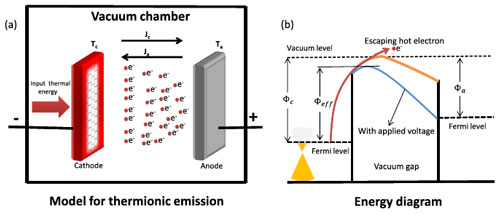| Posted: Mar 05, 2015 | |
A thermionic energy converter using single-layer graphene |
|
| (Nanowerk Spotlight) Heat energy can be converted into electricity with very high efficiency through a temperature-induced electron flow process known as thermionic emission. The basic operating principle of thermionic energy converters is that electrons are evaporated from a heated cathode into a vacuum and then condensed at a cooler anode. After the first practical demonstration in 1957, thermionic energy converters have been used with different heat sources, all of them requiring operation at high temperatures – above 1500 K. | |
| While operation of thermionic energy converters at relatively low temperature (700 K - 900 K) is possible, the efficiency of the process – which normally is > 50% – is greatly reduced since the number of emitted electrons per unit area from the cathode depends on the heating temperature. | |
| For traditional cathode materials – such as metals and semiconductors – the number of emitted electrons is proportional to the square of cathode temperature. However, a recent study demonstrates that the 'square' is revised to 'cubic' for a single-layer graphene, which means that heat temperature can be lowered by an order of magnitude if using graphene as hot cathode. The findings indicate that a graphene-based cathode thermionic converter operating at 900 K could reach an efficiency of 45%. | |
| In a paper in Physical Review Applied ("Electron Thermionic Emission from Graphene and a Thermionic Energy Converter"), Shi-Jun Liang and L. K. Ang from Singapore University of Technology and Design propose a model to investigate the electron thermionic emission from single-layer graphene and to explore its application as the emitter of a thermionic energy converter. | |
 |
|
| (a) Schematic diagram of the electron thermionic emission process of a graphene-based TIC, where Tc and Ta are the cathode temperature and anode temperature, respectively; Jc and Ja are the current flow from cathode to anode and from anode to cathode, respectively. (b) The energy level for the TIC shown in (a). Φc and Φa are the work function of the cathode and of the anode, respectively. Φeff is the effective barrier height of the cathode due to the Schottky lowering effect. The orange (blue) line represents the potential profile without (with) the Schottky lowering effect. The red line traces the thermionic emission process of a hot electron into vacuum. (© American Physical Society) (click on image to enlarge) | |
| "The main findings of our work are centered on two aspects," Liang tells Nanowerk: "First of all, we find the traditional Richardson's law, which describes electron thermionic emission from materials, does not hold for single-layer graphene, due to the unique linear band structure of graphene. "Subsequently, we establish a novel thermionic emission law for graphene." | |
| Based on the novel thermionic emission mechanism, the researchers propose that a graphene-based cathode energy converter can find its application in re-use of industrial waste heat, which often reaches a temperature range of 700 K to 900 K. | |
| "This novel thermionic emission mechanism can also be used as a tool to study carrier transport through graphene-based interfaces," Liang points out. "This is key in understanding the fundamental physical picture, and further figuring out where we can work toward optimizing the performance of devices." | |
| "For example" he adds, "recently there have been numerous research reports on graphene-based solar cells. However, all the scientists still used the conventional equations to understand the I-V characteristic. Our finding is expected to correct the understanding of fundamental transport mechanism." | |
| Liang notes that traditional thermionic emission, which is governed by Richardson-Dunshman equation, is often used for metal or narrow band-gap semiconductor: "It played an important role in the development of vacuum electronics. Most people think that this is a general law. However, with the emergence of two-dimensional materials – like graphene, which has a linear band dispersion different from parabolic dispersion of conventional metals and semiconductors – researchers still use the Richardson-Dunshman equation to describe the thermionic emission from graphene. But in graphene, electrons behave like massless fermions, displaying zero effective mass. This situation contradicts the massive electron emission in the Richardson-Dunshman equation. Therefore, we think that the Richardson-Dunshman equation fails to describe thermionic emission from graphene." | |
| The new model introduced by Liang and Ang could benefit the design of a graphene-based energy converter. Solid-state energy converters, which mostly are thermoelectric generators, usually work inefficiently in the low temperature range (with an efficiency of less than 7%). But, according to the researchers, graphene-based solid state power generator can be expected to have an efficiency of more than 10%. | |
| "In addition" says Liang, "the established equation might prove quite useful in electronics and opto-electronics, like graphene-based photo-detectors, solar cells, even novel types of transistors." | |
 By
Michael
Berger
– Michael is author of three books by the Royal Society of Chemistry:
Nano-Society: Pushing the Boundaries of Technology,
Nanotechnology: The Future is Tiny, and
Nanoengineering: The Skills and Tools Making Technology Invisible
Copyright ©
Nanowerk LLC
By
Michael
Berger
– Michael is author of three books by the Royal Society of Chemistry:
Nano-Society: Pushing the Boundaries of Technology,
Nanotechnology: The Future is Tiny, and
Nanoengineering: The Skills and Tools Making Technology Invisible
Copyright ©
Nanowerk LLC
|
|
|
Become a Spotlight guest author! Join our large and growing group of guest contributors. Have you just published a scientific paper or have other exciting developments to share with the nanotechnology community? Here is how to publish on nanowerk.com. |
|
